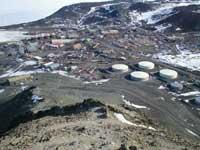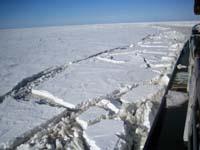Arctic, black to white
2009/06/13 Galarraga Aiestaran, Ana - Elhuyar Zientzia
Unlike Antarctica, the Arctic lacks environmental protection agreements. The treaty of Antarctica was born in 1959 and is effective until 2041. According to this, Antarctica cannot be used for military purposes, there is freedom of scientific research and natural resources are protected. The commercial exploitation of Antarctica is strictly prohibited.

The Arctic thaw allows a greater exploitation of energy resources. Now, in addition, they have made a thorough calculation of reservations and know where and how much there is. (Photo: AWI)
This does not happen with the Arctic. Countries surrounding the Arctic Ocean (Russia, Canada, Denmark, Norway, Sweden, Finland and the US) They have exploited the resources as much as possible, and if they have not exploited them, it is because the Arctic conditions make exploitations much more difficult and expensive. In recent times, however, due to the thaw, areas that were previously difficult to reach are becoming more accessible.
In addition, thanks to the work of the U.S. Department of Geology, they now know with great precision how much fuel there is and where there is. Thus, it is estimated that 3% of the oil that remains unexploited in the world is in the Arctic, triple the annual consumption. However, they have seen that there is more gas than oil, 14 times more than what is consumed in a year in the world.
Many of these reserves are more than 500 meters deep, in places that can be relatively easy to exploit. And most of it is in the countryside of Russia. The Russians already have some farms in the Arctic and have always intended to exploit more. In addition, it has tried to expand the corresponding area.
Russia, leader of Russia
The most prominent essay was done two years ago. The United Nations Sea Law limits the area that a country can economically exploit 200 miles from the mainland. Russia declared to the United Nations in 2001 that a background area of the North Pole, the Lomonosov mountain range, was the continuation of the Russian continental plate. It received no approval, but however, in 2007, through a submarine, a geological investigation was carried out in which the Russian flag was placed under the North Pole at 4,200 meters of depth.
The enemies then accused Russia of ambition, but they also showed that they were technically able to do so. Again, it is expected that the fuel that hides under the icy waters can be extracted easily and economically.
According to U.S. geologists who have carried out a study of resources, the start-up of Russian farms will have no consequences on the fuel market, since there is not enough oil to change the market and that, despite the large reserves of gas, Russia is already the world's largest producer of gas. That is, they will continue to dominate the gas market. However, geologists warn that it can have a great impact on the environment.
And above all, ecologists and institutions that care about the environment. Not because it is Russia in particular, because the US does not guarantee that it will not explode to get fuel. In fact, last year it lifted a ban for 17 years that prohibited drilling the coast. But the largest reserves are concentrated in the areas of Russia, which has already announced its intention to exploit them.
In any case, it is not necessary to go so far to see in front of the economic interests of companies exploiting natural resources against those responsible for the environment; we also have around us some examples...
Published in Gara

Gai honi buruzko eduki gehiago
Elhuyarrek garatutako teknologia





